
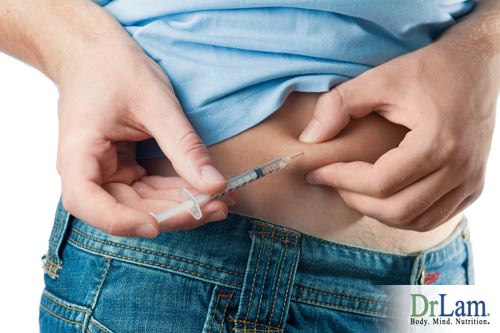 Of the 15 million Americans who have Type II diabetes, more than a third are unaware of it. Another 21 million Americans have a greater than 50/50 chance of developing the disease because they have impaired blood-sugar metabolism. This year alone more than 187,000 people will die of Type II diabetes, also called non-insulin-dependent diabetes mellitus (NIDDM), making it the sixth leading cause of death by disease. Each day, over 2,200 people are diagnosed with this chronic life debilitating, expansive, and pro-aging disease. Learning about supplements for diabetes prevention and treatment is essential to a long and healthy life.
Of the 15 million Americans who have Type II diabetes, more than a third are unaware of it. Another 21 million Americans have a greater than 50/50 chance of developing the disease because they have impaired blood-sugar metabolism. This year alone more than 187,000 people will die of Type II diabetes, also called non-insulin-dependent diabetes mellitus (NIDDM), making it the sixth leading cause of death by disease. Each day, over 2,200 people are diagnosed with this chronic life debilitating, expansive, and pro-aging disease. Learning about supplements for diabetes prevention and treatment is essential to a long and healthy life.
Glucose is a simple sugar found in food. It is an essential nutrient that provides energy for the proper functioning of the body cells. After meals, food is digested in the stomach and the intestines into glucose and other nutrients. The glucose in digested food is absorbed by the intestinal cells into the bloodstream, and is carried by blood to all the cells in the body. However, glucose cannot enter the cells alone. It needs assistance from insulin in order to penetrate the cell walls. Insulin therefore acts as a regulator of glucose metabolism in the body.
Insulin is called the "hunger hormone". As the blood sugar level increases following a carbohydrate rich meal, the corresponding insulin level rises with the eventual lowering of the blood sugar level and glucose is transported from the blood into the cell for energy. When the blood glucose levels are lowered, the insulin release from the pancreas is turned off. When the blood sugar level drops below a certain level, hunger is felt. This often occurs a few hours after the meal. In normal individuals, such a regulatory system helps to keep blood glucose levels in a tightly controlled range. Cravings for sweets frequently form part of this cycle, which can lead to snacking, often for more carbohydrates. If the cravings are not fulfilled, sensations such as hunger, dizziness, moodiness, and a state of "collapse" can result.
This system of auto regulation and homeostasis is the function of the pancreas and it works around the clock. Dysfunction of this auto regulation system - either inability of the pancreas to secrete any or insufficient insulin, or pancreas overload from too much sugar ingested over a long period of time, or over compensatory mechanism, or a combination of these, results in the lack of insulin, and hence high blood sugar. This is the hallmark of diabetes mellitus (commonly called diabetes).
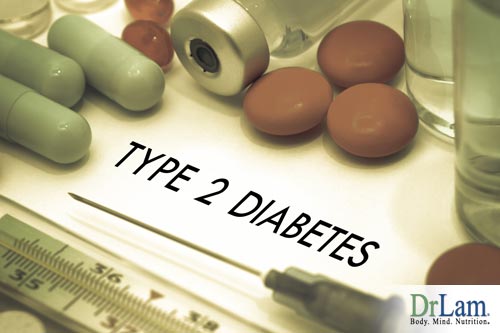 Type II diabetes mellitus is also referred to as non-insulin dependent diabetes mellitus (NIDDM), or adult onset diabetes mellitus (AODM). It is a metabolic disorder resulting from the body's inability to make enough, or properly use, insulin. 90% of all Diabetes Mellitus are of Type II. Type II diabetes mellitus occurs mostly in individuals over 40 years old. The incidence of type II diabetes increases with age. Unlike type I diabetes mellitus, 80% of type II diabetic patients are obese. Type II diabetes mellitus also has a strong genetic tendency.It is nearing epidemic proportions, due to an increased number of elderly people, a greater prevalence of obesity and a sedentary lifestyle. In type II diabetes, patients can still produce insulin, but do so inadequately. The pancreas in these patients not only produces an insufficient amount of insulin, but also releases insulin late in response to increased glucose levels. Some type II diabetics have body cells that are resistant to the action of insulin (Insulin Resistance). Finally, the liver in these patients continues to produce glucose despite elevated glucose levels.Type II diabetes once hardly ever struck before middle age, and the older you are the more at risk you are. Now it is striking younger people.
Type II diabetes mellitus is also referred to as non-insulin dependent diabetes mellitus (NIDDM), or adult onset diabetes mellitus (AODM). It is a metabolic disorder resulting from the body's inability to make enough, or properly use, insulin. 90% of all Diabetes Mellitus are of Type II. Type II diabetes mellitus occurs mostly in individuals over 40 years old. The incidence of type II diabetes increases with age. Unlike type I diabetes mellitus, 80% of type II diabetic patients are obese. Type II diabetes mellitus also has a strong genetic tendency.It is nearing epidemic proportions, due to an increased number of elderly people, a greater prevalence of obesity and a sedentary lifestyle. In type II diabetes, patients can still produce insulin, but do so inadequately. The pancreas in these patients not only produces an insufficient amount of insulin, but also releases insulin late in response to increased glucose levels. Some type II diabetics have body cells that are resistant to the action of insulin (Insulin Resistance). Finally, the liver in these patients continues to produce glucose despite elevated glucose levels.Type II diabetes once hardly ever struck before middle age, and the older you are the more at risk you are. Now it is striking younger people.The early symptoms of untreated diabetes mellitus are related to elevated blood sugar levels, and excretion of it to the urine. High amounts of glucose in the urine can cause increased urine output and lead to dehydration. Dehydration causes increased thirst and water consumption. Some untreated diabetic patients also complain of fatigue, nausea, and vomiting. Patients with diabetes are prone to developing infections of the bladder, skin, and vaginal areas. Fluctuations in blood glucose levels can lead to blurred vision. Extremely elevated glucose levels can lead to lethargy and coma (diabetic coma).
The most unrecognized symptom of NIDDM is weight gain. High insulin levels prohibit the release of serotonin, a neurotransmitter in the brain that informs the body to slow down eating. Without serotonin, there is a tendency to overeat, which then leads to a spiral of excessive sugar intake. A viscous cycle of hyper-insulinemia resulting in insulin resistance is set up. This in turn creates a "carbohydrate addict" whose craving for a higher sugar intake continues to increase. The same dietary factors that cause NIDDM lead to obesity. Eating refined carbohydrates such as sugar, or carbohydrates that easily converts into sugar such as yam, potato, or rice, creates more glucose than the body can handle. Excess glucose then gets stored as fat. As diabetes sets in, so does lethargy and inactivity, contributing further to the vicious cycle of weight gain and worsening of diabetes.
The fasting plasma glucose test is the standard and preferred way to diagnose diabetes. Normal fasting plasma glucose levels are less than 110 milligrams per deciliter (mg/dl). If the overnight fasting blood glucose is greater than 126 mg/dl on two different tests on different days, the diagnosis of diabetes mellitus is made. Random blood glucose alone is seldom used because it is not reliable.
Fasting blood sugar can be performed using a simple home blood sugar (glucose) testing kit. Many doctors also take the hemoglobin A1C level. This is a test to measure of the overall effectiveness of blood glucose control over a period of time (two months). Elevated hemoglobin A1C levels indicate a poor overall control of blood sugar.
 Insulin is vital to patients with type I diabetes. Without insulin, patients with type I diabetes can develop severely elevated blood sugar levels. This leads to increased urine glucose, which in turn leads to excessive loss of fluid and electrolytes in the urine. Lack of insulin also causes the breakdown of fat cells, with the release of ketones into the blood. Symptoms of diabetic ketoacidosis include nausea, vomiting, and abdominal pain. Without prompt medical treatment, patients with diabetic acidosis can rapidly go into shock, coma, and even death. With proper treatment, the symptoms can be reversed rapidly, and patients can recover remarkably well.
Insulin is vital to patients with type I diabetes. Without insulin, patients with type I diabetes can develop severely elevated blood sugar levels. This leads to increased urine glucose, which in turn leads to excessive loss of fluid and electrolytes in the urine. Lack of insulin also causes the breakdown of fat cells, with the release of ketones into the blood. Symptoms of diabetic ketoacidosis include nausea, vomiting, and abdominal pain. Without prompt medical treatment, patients with diabetic acidosis can rapidly go into shock, coma, and even death. With proper treatment, the symptoms can be reversed rapidly, and patients can recover remarkably well.
Short term complications are normally due imbalance of sugar level in the body as a result of:
Long-term complications are related to blood vessel diseases. Diabetes causes diseases of the small vessels, which can damage the eyes, kidneys, nerves, and heart. Four major areas are involved:
 Heart Disease and Strokes. Patients with diabetes are 2-4 times more likely to have heart disease, which is present in 75 percent of diabetes-related death (more than 75,000 deaths due to heart disease annually). Diabetic patients are also 2 to 4 times more likely to suffer a stroke. Diabetes also accelerates the hardening of the arteries (atherosclerosis) of the larger blood vessels, leading to coronary heart disease (angina or heart attack), strokes, and pain in the lower extremities because of lack of blood supply.
Heart Disease and Strokes. Patients with diabetes are 2-4 times more likely to have heart disease, which is present in 75 percent of diabetes-related death (more than 75,000 deaths due to heart disease annually). Diabetic patients are also 2 to 4 times more likely to suffer a stroke. Diabetes also accelerates the hardening of the arteries (atherosclerosis) of the larger blood vessels, leading to coronary heart disease (angina or heart attack), strokes, and pain in the lower extremities because of lack of blood supply.Diabetic men were more than twice as likely to die of all causes compared with men without diabetes. As blood glucose increased, the risk of dying climbed higher regardless of age, weight, blood pressure, cholesterol and smoking status.
Researchers estimated that a reduction in blood glucose by just 0.1 per cent could reduce mortality rates by about five per cent in western countries.
An aggressive and intensive control of elevated levels of blood sugar in patients with diabetes is absolutely essential. Studies have shown that in intensively treated patients, diabetic eye disease decreased by 76%, kidney disease decreased by 54%, and nerve disease decreased by 60%.
Aggressive control with intensive therapy means achieving fasting glucose levels between 70-120 mg/dl; glucose levels of less than 180 mg/dl after meals; and a near normal hemoglobin A1C levels.
Not only will you feel better, stay healthy, and have more energy. You will also live longer.
Diabetes is a disease that has become prevalent only in the past 100 years. Before then, when everyone ate whole foods and sugar intake was moderate, diabetes was hardly a problem. It's a simple of matter of supply and demand. If the ingestion of grain products and refined sugars exceed the demand, the body is put into high gear to rid itself of the excess sugar. Diabetes is resulted when this process carries on for an extended period of time and ultimately fails. No other disease state can be cured as easily as NIIDM.
All you have to do is to reduce the supply of sugar to the body to a moderate level without sacrificing energy production. The secret lies not in avoiding carbohydrates as the most common source of sugar. The key is knowing what kind of carbohydrate to eat and which kind to avoid.
The major goal in treating diabetes mellitus is controlling elevated blood sugars (glucose) without causing abnormally low levels of blood sugar. Type I diabetes mellitus is treated with insulin, exercise, and a diabetic diet. Type II diabetes mellitus is treated with concurrent employment of nutritional supplements for diabetes, a low glycemic index diet to control blood sugar level, and exercise. If these measures fail to contain the elevated blood sugars, oral medications and insulin need to be considered.
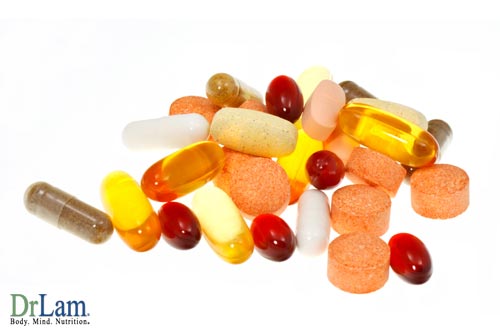 A variety of nutrients and herbs can help offset the toll diabetes takes on your body. Supplements for diabetes cannot, however, reverse the disease by themselves. Incorporating these minerals and vitamins can help to normalize blood sugar. If you already have diabetes or suspect you might have it, consult a health care practitioner before taking any supplements for diabetes.
A variety of nutrients and herbs can help offset the toll diabetes takes on your body. Supplements for diabetes cannot, however, reverse the disease by themselves. Incorporating these minerals and vitamins can help to normalize blood sugar. If you already have diabetes or suspect you might have it, consult a health care practitioner before taking any supplements for diabetes.
Chromium is an essential trace mineral nutrient. Like iron, zinc, selenium, copper, and several other essential trace minerals, chromium plays a critical role in maintaining normal health and well-being.
Chromium helps insulin work efficiently. Many well controlled clinical studies through the years and the majority show blood glucose improvements in the patients tested.
Important studies include one from the Human Nutrition Research Center of the United States Department of Agriculture conducted in 1996. Researchers in the study randomized 180 adult-onset diabetics into 3 groups of 60 each: one group received placebo twice per day, the second received 100 mcg twice daily of chromium as chromium picolinate and the third received 500 mcg of chromium as chromium picolinate twice daily. Their blood work was examined at baseline, at 2 months and at 4 months. The patients were told to remain on their anti-diabetic medications and continue with their diets and activity levels as before. The results were impressive: blood glucose, insulin levels, cholesterol and Hemoglobin A1C all decreased, with the higher dose generally (but not always) more effective than the 200 mcg.
Few foods are rich sources of chromium in the Western diet, the best being organic meats, mushrooms, wheat germ, broccoli and processed meats. Data from U. S. Government sources show that the great majority of Americans get less chromium in their daily diets than the amount recommended by nutrition experts. The RDA Committee recommends 50-200 mcg of chromium/day; the vast majority of Americans get less than 50 mcg/day. It is estimated that as many as 80% of all Americans are deficient in this mineral and may not know it.
Unfortunately, it is not possible to get enough chromium by food alone without excessive calories and obesity. To obtain 200 mcg by food alone, one has to take in over 8,000 calories a day. A large part of the problem has to do with processed food and the increase consumption of sugar. The modern American consumes an average of 120 pounds of sugar per year from all sources. These ingested sugars (such as table sugar and products made with it) bring insulin and chromium into the blood and cause chromium to be excreted in the urine after it's through working with the insulin on the increase in blood sugar.
Inadequate chromium intake from processed food, increased chromium losses due to increased sugar consumption, decreasing chromium tissue levels as we age are the main reasons why the majority of Americans and diabetics are deficient in chromium. Studies show an improvement in blood sugar in significant numbers of diabetics and pre-diabetics with modest amounts chromium supplements for diabetes. Chromium as supplements for diabetes should, however, take place alongside the two other proven ways of normalizing sugar: low-fat, high complex-carbohydrate of low glycemic index type diets for weight loss/weight maintenance and regular exercise.
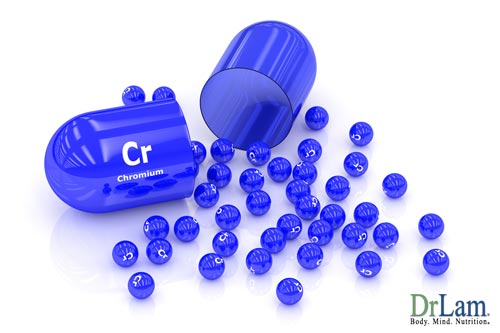 Deciding whether or not someone is chromium deficient cannot be done easily. Routine blood tests are generally not accurate. The only generally accepted method for the assessment of chromium status is to supplement an individual who has abnormalities of either blood sugar, cholesterol, triglycerides or all three with the trace element. If the laboratory values improve, then chromium insufficiency is presumed.
Deciding whether or not someone is chromium deficient cannot be done easily. Routine blood tests are generally not accurate. The only generally accepted method for the assessment of chromium status is to supplement an individual who has abnormalities of either blood sugar, cholesterol, triglycerides or all three with the trace element. If the laboratory values improve, then chromium insufficiency is presumed.
Chromium comes in various forms. The dietary form is called chromium tri-valent. This is non-toxic and necessary for essential bodily functions. Chromium in its hexa-valent form is used in industries and that is highly toxic.
It is extremely difficult to poison laboratory animals with oral dietary tri-valent forms of chromium. For example, cats fed 1,000 mg of trivalent chromium per day showed no signs of toxicity. The equivalent daily dose for a 150 lb person would be approximately 35,000 mg per day or 3.5 million mcg per day. In terms of the number of 200 mcg tablets, this would be 175,000 tablets per day for a human.
"Trivalent chromium has such a low order of toxicity that deleterious effects from excessive intake of this form of chromium do not occur readily. Trivalent chromium becomes toxic only at extremely high amounts - chromium then acts as a gastric irritant rather than as a toxic element interfering with essential metabolism or biochemistry." Modern Nutrition In Health and Disease, Eighth Ed., 1994. Shils, Olson and Shike, eds.
The safety issue had been questioned by a study published in December 1995, which attempted to link chromosomal damage in the test tube to oral supplementation of chromium picolinate. Researchers in this study added unnaturally high amounts of chromium picolinate to cultured Chinese hamster ovarian cancer. Some of these cells showed chromosomal damage. This was not particularly surprising, since this concentration applied was 3,000 times the blood level of people who are ingesting chromium picolinate as supplements. It is interesting to note that another form of chromium, chromium polynicotinate, did not have this toxic effect.
It is important to note that very few essential minerals tested in this way would be found to be without toxicity. For example, merely doubling the blood concentration of the mineral calcium is fatal to humans.
A further study was conducted by Dr. Richard Anderson, the lead scientist for trace minerals at the U.S. Department of Agriculture's Human Nutrition Research Center, Beltsville, Md., His research team fed rats a stock diet. Added to the diet was 0, 5, 25, 50 or 100 micrograms (mcg) of chromium per gram of feed for a period of six months. The supplements were added to the feed in the form of chromium chloride or chromium picolinate. The highest supplemented level measured approximately 1500 mcg/day per kilogram of body weight. Translated to a human equivalent would mean that a 150 lb (70 kg) individual would have to consume 1.05 million micrograms, or more than 5,000 tablets containing 200 mcg of chromium each daily for six months to equal the rat intake. This study found no harmful effects in animals supplemented with two widely used forms of dietary chromium: chromium chloride and chromium picolinate.
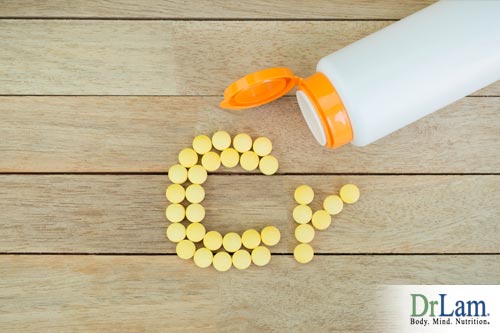 There are various forms of dietary chromium supplements for diabetes. These vary in bioavailability (absorption and retention) and biological activity (ability to potentate and harmonize insulin). Inorganic chromium such as chromium chloride is unfortunately poorly absorbed (0.5-2%) and has little effect on insulin because it must first be converted into a biologically active form, which the body has a limited ability to do.
There are various forms of dietary chromium supplements for diabetes. These vary in bioavailability (absorption and retention) and biological activity (ability to potentate and harmonize insulin). Inorganic chromium such as chromium chloride is unfortunately poorly absorbed (0.5-2%) and has little effect on insulin because it must first be converted into a biologically active form, which the body has a limited ability to do.
The two most popular forms of organic chromium are niacin-bound chromium (also called chromium polynicotinate) and chromium picolinate. Although picolinate and polynicotinate sound alike, there are significant differences between the two compounds.
Chromium Polynicotinate is actually a family of niacin-bound chromium compounds. Niacin-bound chromium strongly potentiates insulin - chromium's most vital function - while chromium picolinate is less effective comparatively speaking.
Niacin-bound chromium such as chromium polynciotinate is also more bioavailable than chromium picolinate. An Animal study at the University of California found that chromium polynicotinate is better absorbed and retained up to 311% better than chromium picolinate and 672% better than chromium chloride. Such high bioavailability means that chromium polynicotinate can deliver more of the benefits that chromium has to offer.
Vitamin C is among greatest supplements for diabetes. As a strong antioxidant, this vitamin enhances capillary strength, which improves blood flow. Dietary sources including leafy greens, broccoli, peppers, oranges, and grapefruit are the primary source of dietary vitamin C, followed by commercial supplements.
Vitamin C administration has beneficial effects on sugar and fat metabolism in NIIDM. In a randomized double-blind cross-over study, in which 56 diabetic patients participated, it has been established that a supplementation of high doses of ascorbic acid (2 grams a day) markedly improves the blood sugar regulation in patients with NIDDM. It was recorded that the vitamin C supplementation in the NIDDM group resulted in a statistically significant decrease of the fasting blood sugar of 10.1 to 9.1 mmol/liter. In this group the vitamin C supplement also succeeded in lowering the level of LDL cholesterol and of triglycerides in the blood. The greater the amount of vitamin C taken, the greater reduction in LDL cholesterol and plasma free radicals. The plasma free radicals are also lower compared to the placebo group. This was reported in the Journal of the American College of Nutrition (Aug. 1995).
Vitamin C also reduces the potential of complications arising from persistent high sugar environment in the body. Specifically, vitamin C supplements for diabetes treatment prevents accumulation of sorbitol (a sugar equivalent) in cells and protect against most complications resulting from oxidation. A large population based study found that patients with high blood levels of Vitamin C had a lower HbA1C.
Furthermore, patients with diabetes have low levels of Vitamin C in their cells, which can result in impaired wound healing. High dose Vitamin C supplements for diabetes have been shown to prevent sorbitol accumulation and glycosilation of proteins, both of which are important factors in the development of diabetic complications such as cataracts. 1 to 2 gram daily of Vitamin C supplements for diabetes treatment is recommended.
In the family of supplements for diabetes, Vitamin E is among the best. Vitamin E reduces oxidative stress, thus improving membrane physical characteristics and related activities in glucose transport.
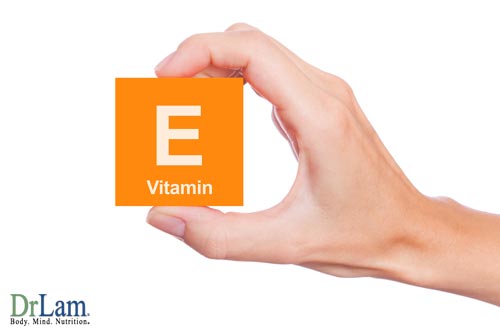 This antioxidant promotes healing of diabetes-related lesions, whose cause is undetermined. Researchers have extensively investigated the possible effects of vitamin E supplementation on the cardiac autonomic nervous system in patients with type 2 diabetes and cardiac autonomic neuropathy. It was reported in the American Journal of Clinical Nutrition that daily Vitamin E supplements for diabetes (600 mg) for 4 months improved the ratio of cardiac sympathetic to parasympathetic tone in patients with NIIDM. This effect might be mediated by a decline in oxidative stress. In short, Vitamin E (800 to 1200 I.U.) improves insulin action and prevents a host of long-term complications of diabetes including neuropathy.
This antioxidant promotes healing of diabetes-related lesions, whose cause is undetermined. Researchers have extensively investigated the possible effects of vitamin E supplementation on the cardiac autonomic nervous system in patients with type 2 diabetes and cardiac autonomic neuropathy. It was reported in the American Journal of Clinical Nutrition that daily Vitamin E supplements for diabetes (600 mg) for 4 months improved the ratio of cardiac sympathetic to parasympathetic tone in patients with NIIDM. This effect might be mediated by a decline in oxidative stress. In short, Vitamin E (800 to 1200 I.U.) improves insulin action and prevents a host of long-term complications of diabetes including neuropathy.
In another study, 21 NIIDM patients with microangiopathic complications were divided into 2 groups, in which 11 patients took 900 mg of vitamin E supplements for diabetes daily and the other group of 10 diabetic patients took a placebo daily for 6 months. The vitamin E was provided in tablets containing 100 mg of dl-alpha-tocopheryl acetate. The mean age of these subjects was 58 years. This study showed that these diabetic patients had impaired erythrocyte osmotic fragility, and that pharmacological doses of vitamin E supplements for diabetes increased the resistance of erythrocytes to osmotic hemolysis in patients with microangiopathy.
Vitamin E also appears to play a significant role in the prevention of diabetes. Studies have shown that a low vitamin-E concentration was associated with a 3.9 times greater risk of developing diabetes.
Largely because of our modern diets, which are deficient in enzymes, most of us deplete our body's natural enzyme level as we age. Tests have shown that a 70-year-old person has only about half the enzyme level of a 20-year-old. A newborn baby has 100 times the enzymes levels of an elderly person! As we become enzyme-deficient, we age faster. Lack of enzymes also puts stress on vital organs like the pancreas, liver and spleen, causing a metabolic deficit.
Unfortunately, cooking any food at temperatures above above 116 degrees Fahrenheit kills all enzymes. All canned or bottled foods contain no enzymes because they are cooked before being processed.
Raw vegetables and fruits can be an excellent natural source of enzymes if they are allowed to ripen. Unfortunately, they contain no enzymes when they are picked "green" (often the case in supermarkets because they have to be transported over long distances). Enzymes can only develop when they ripen on the plant. Irradiating food, or treating it with preservatives can also kill enzymes.
Enzymes in raw food can actually digest as much as 75 percent of the food itself without the help of enzymes secreted by your body. Without sufficient enzyme levels, the foods you eat can't be completely broken down and absorbed. Diabetics have a greatly weakened state of their pancreas and digestive tract. Two common deficiencies in the diabetic are lipase and amylase.
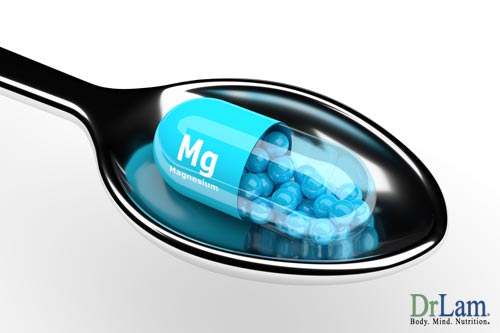 Magnesium is involved in many areas of glucose metabolism. Its deficiency is common among diabetics. Supplementation of magnesium may prevent some of the complications of diabetes, such as retinopathy and heart disease. Magnesium is one of the top supplements for diabetes patients. The RDA for magnesium is 350 mg day for adult males and 300 mg for adult females. The diabetic may need 700 mg. The average diet contains about 200 mg a day, so the majority of adults are deficient. Magnesium occurs abundantly in whole foods such as seeds, nuts, whole grains, and green leafy vegetables, but food processing takes out a large portion. Another reason why magnesium is among the top supplements for diabetes. In addition to magnesium at least 50 mg of vitamin B6 should be taken, as the level of intracellular vitamin B6 appears to be linked to the magnesium content of the cell. Without adequate B6, magnesium's entrance into the cell is impaired.
Magnesium is involved in many areas of glucose metabolism. Its deficiency is common among diabetics. Supplementation of magnesium may prevent some of the complications of diabetes, such as retinopathy and heart disease. Magnesium is one of the top supplements for diabetes patients. The RDA for magnesium is 350 mg day for adult males and 300 mg for adult females. The diabetic may need 700 mg. The average diet contains about 200 mg a day, so the majority of adults are deficient. Magnesium occurs abundantly in whole foods such as seeds, nuts, whole grains, and green leafy vegetables, but food processing takes out a large portion. Another reason why magnesium is among the top supplements for diabetes. In addition to magnesium at least 50 mg of vitamin B6 should be taken, as the level of intracellular vitamin B6 appears to be linked to the magnesium content of the cell. Without adequate B6, magnesium's entrance into the cell is impaired.
These are some of the important supplements for diabetes prevention and treatment. Supplements for diabetes should always be started slowly. Before starting any supplements for diabetes, always consult your Primary Care Provider.
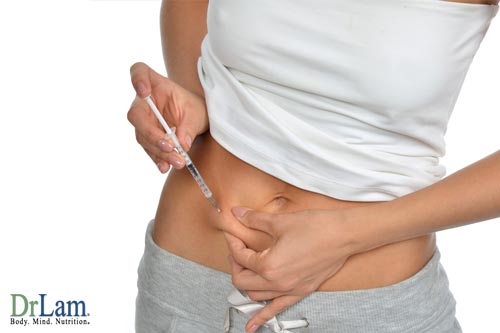 Do you suffer from diabetes? Do you find it difficult to figure out what is best for you to eat? Do you think you could benefit from a food pyramid for diabetes? Would a food pyramid for diabetes help you gain more control over you health? Keep reading to learn more about what a food pyramid for diabetes looks like and how you or someone you love may benefit from utilizing it.
Do you suffer from diabetes? Do you find it difficult to figure out what is best for you to eat? Do you think you could benefit from a food pyramid for diabetes? Would a food pyramid for diabetes help you gain more control over you health? Keep reading to learn more about what a food pyramid for diabetes looks like and how you or someone you love may benefit from utilizing it.
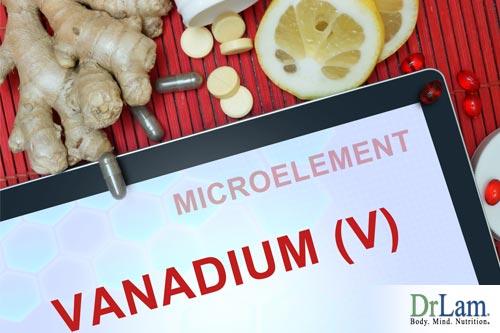 Vanadium: The amount of vanadium we get in our diet appears to be 50-60 mcg. In the therapeutic use in diabetes management, the dosage required is often 1000-fold greater. Unfortunately, vanadium compounds have not been extensively tested in clinical trails. The use of vanadium for treatment of diabetes should best be taken under the supervision of a knowledgeable physician.
Vanadium: The amount of vanadium we get in our diet appears to be 50-60 mcg. In the therapeutic use in diabetes management, the dosage required is often 1000-fold greater. Unfortunately, vanadium compounds have not been extensively tested in clinical trails. The use of vanadium for treatment of diabetes should best be taken under the supervision of a knowledgeable physician.Dietary control of diabetes comes down to 2 simple principles:
A food pyramid for diabetes could help you to understand and comprehend what this looks like in daily life.
The glycemic indexrepresents the magnitude of the increase in blood glucose that occurs after ingestion of the food. This index measures how much your blood sugar increases in the two or three hours after eating.
When you make use of the glycemic index to prepare healthy meals, it helps to keep your blood sugar levels under control. GI tends to be lower for foods that are present in relatively large particles, minimally processed, and are ingested along with fat and protein.
Below are the general guidelines to what is considered high or low Glycemic Index (GI) foods.
The following foods are considered unacceptable:
Look at what you can have:
Take a look at this food pyramid for diabetes to help gain persepctive.
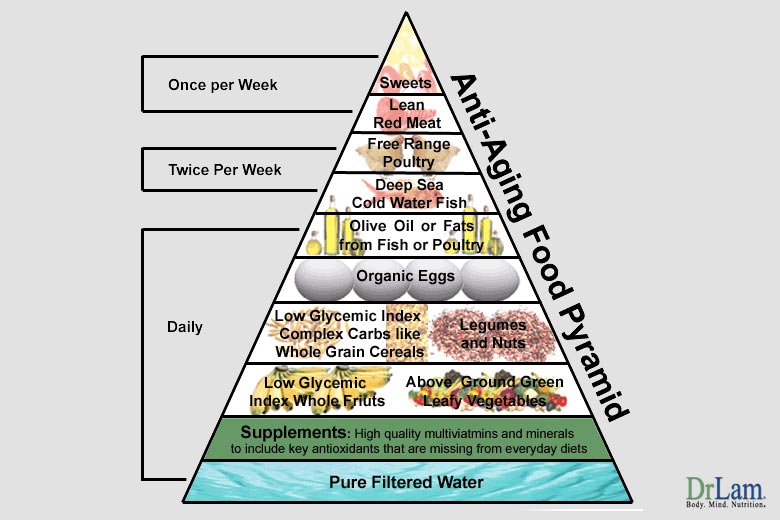
This Diet consists of 50-55% complex carbohydrates of low glycemic type (whole fruits, above ground vegetables, whole grains), 20-25% protein (preferably from plant sources), 25-30% fat. The normal 5% sweets, candies and dessert should be avoided.
There are three major layers to the Anti-Aging Food Pyramid or Food Pyramid for Diabetes. They are divided into daily, 2-3 times a week, and weekly layers. Imagine a pyramid with three layers, each layer getting much narrower as it gets closer to the tip.
The daily broad base layers of the pyramid starts with 10 glasses of pure filtered water a day and complex carbohydrates supplying up to 55% of the calories These carbohydrates are those of low glycemic index type - barley, cereal, legumes, and above ground vegetables. A limited amount of nuts, which is a fatty food, is also included in this first base layer. Three servings of vegetables should be eaten daily. High glycemic index complex carbohydrates such as wheat, rice, and corn should be restricted. Moderate amounts are acceptable if they are mixed with fat and protein.
Eggs also form part of the base layers. It is a good protein source. One egg per day is acceptable (including those used in cooking and baking). Organic eggs are the best.
Olive oil and fats from fish; nuts are part of this daily layer. 25-30% of the calories in your comes from fats. The fats in the diet should come mainly from olive oil, which is high in monounsaturated fats and also a good source of antioxidant. Some come from the fish, poultry and meat consumed.
The second layer is a much smaller layer containing protein food from fish and poultry. You should eat from this group 2-3 times a week. Fish should be those that live in deep and cold water, such as salmon and tuna. Poultry should preferably come from free-range chickens.
The third layer, which is very small, contains foods that one should eat 1 time a week. These include sweets, red meat (lean). If blood sugar is severely impaired, sweets should be avoided altogether.
 Celery, Bitter Melon, Onion, Garlic, Globe Artichoke, Jerusalem artichoke, Asparagus and Spinach are vegetables that alleviate Diabetes Mellitus.
Celery, Bitter Melon, Onion, Garlic, Globe Artichoke, Jerusalem artichoke, Asparagus and Spinach are vegetables that alleviate Diabetes Mellitus.No diabetes program is complete without a well-balanced exercise program. While most people think of exercise as a way to reduce body weight, exercise does much more, including reducing insulin resistance and impotence.
A well-balanced exercise must include three components:
According to the proper protocol and food pyramid for diabetes, ideally, about 2000 calories should be burned per week. Working out with 30 minutes of aerobics exercise at moderate intensity 5 times a week plus 15-20 minutes of strength training 3 times a week will accomplish this goal.
If the above protocol fails, drugs and insulin have to be used. Oral Medications commonly prescribed fall into one of 4 categories:
Type 1 Diabetes Mellitus is a disease that requires insulin to sustain life.
Type 2 Diabetes Mellitus (NIIDM) is a disease that is largely curable.
Treatment of NIIDM from a drug-free perspective includes a protocol consisting of 3 steps taken concurrently and properly utilizing a food pyramid for diabetes:
Auxiliary supplements include alpha lipoic acid 300-500 mg a day, bitter melon 2 ounces a day, blueberry 25 mg two times a day, vitamin B12 500- 2000mcg a day, and gingko biloba 40 to 80 mg three times a day.
If the above fails to control blood sugar, prescription medications should be considered. Conversely, those who are already on medications may be weaned off slowly under the supervision of a physician and following the above protocol. If you want to improve your health start using a food pyramid for diabetes today.